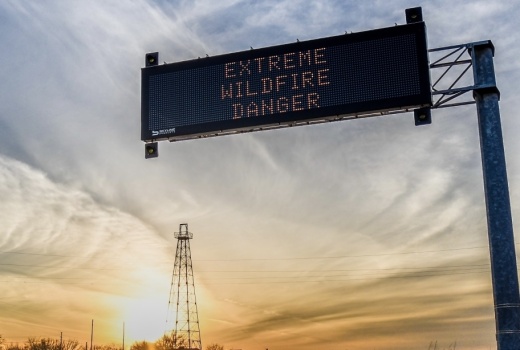Hot and dry conditions lead to a heightened risk for wildfires, due to a lack of fuel moisture, or a minimal amount of water in vegetation. The lower the fuel moisture, the more likely it is for a wildfire to start and spread, according to the National Centers for Environmental Information.
Nine out of 10 wildfires are caused by people, according to Heather Gonzales, a program specialist who focuses on wildfire prevention for the Texas A&M Forest Service.
Texans should be careful doing any activities that may cause sparks, Gonzales said. This includes welding, cutting and grinding materials outdoors. Clearing the vegetation around a workspace and having a water source available can help prevent wildfires, she explained.
The TFS has also seen a recent increase in wildfires caused by vehicles, Gonzales said. The underside of cars, trucks, ATVs and UTVs can get extremely hot and potentially ignite the grass below the vehicle.
Additionally, towing a trailer behind a vehicle can cause a fire if not done properly. If the towing chain is not secured and drags on the road, this may create sparks, Gonzales said.
Wildfires are also caused by unattended campfires, the burning of debris, dropped cigarettes and arson, according to the National Park Service.
Rising fire danger
As of July 20, 215 of Texas’ 254 counties were under burn bans, the TFS reported. Burning debris is prohibited under burn bans and is the leading cause of wildfires in Texas, Gonzales said.
“Just because we've gotten a little bit of precipitation, it hasn't been significant enough to relieve us from drought conditions, and [people should] still obey local burn regulations and restrictions,” Gonzales explained.
This year has been a “much drier year than average,” Gonzales said, and the state has not had this many active burn bans since 2011.
On July 8, Texas Gov. Greg Abbott issued a drought disaster declaration for 164 counties. That number has since risen to 189, with 72 counties under a wildfire disaster declaration as of July 20.
According to the Texas Interagency Coordination Center, there is moderate-to-high fire danger in large portions of Texas. Fire danger is moderate-to-high in and around Austin; moderate-to-very high in and around Houston; high-to-very high in and around Dallas-Fort Worth; and high-to-very high in and around San Antonio. The observed fire danger map was updated July 20.
By July 23, fire danger is expected to increase across the state, according to the TFS’ forecasting tool.
Preparing for the threat of wildfire
The TFS promotes the 'Ready, Set, Go' wildfire action plan, which includes steps to protect families and homes against wildfires.
“It’s not a question of if but when the next major wildfire will occur,” the 'Ready, Set, Go' planning guide said.
Every Texan should have an evacuation plan with multiple ways to leave their home or neighborhood, Gonzales said. Residents should also have a “go kit” with personal items, important documents and supplies for their pets, which can be grabbed quickly during an emergency or evacuation order.
Gonzales also suggests keeping up to date with local authorities or emergency departments and signing up for emergency alert notifications.
The state's emergency response
The TFS leads the response to wildfires across the state, Gonzales said. Officials collaborate with local agencies and provide resources, personnel and incident management.
As directed by Abbott, the Texas Division of Emergency Management is collaborating with the TFS to respond to and control wildfires.
The TDEM organizes the state’s response to disasters and emergencies, including wildfires, through the State of Texas Assistance Request program. Local governments can file requests for aid through STAR. Officials from the TDEM then determine what the community needs and connect people with the right resources, according to Teresa Farfan, a media and communications officer for the TDEM.
The TDEM also coordinates announcements at the state level to make sure people are informed about hazards, emergencies and the state’s response, Farfan said.
As of 7 a.m. July 21, there were 10 active wildfires over an estimated 16,426 acres of land. The TFS updates its website with the level of fire danger daily.
The TFS reported on July 20 the “areas of concern” for wildfires include the eastern Rolling Plains, Cross Timbers, Central Texas, North Texas near Waco/Dallas-Fort Worth and south along Interstate 35 near the Capital. The risk for “significant fires” also includes portions of East Texas, such as Palestine, Crockett, Huntsville, Tyler and Marshall.





